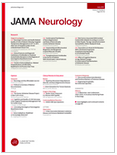 New genomic strategies can now be applied to identify a diagnosis in patients and families with previously undiagnosed rare genetic conditions. This study aimed to determine the genetic cause of a slowly progressive, autosomal dominant, scapuloperoneal neuromuscular disorder in fourteen affected individuals in a 6-generation family. Participants were examined at pediatric, neuromuscular, and research clinics from March 1, 2005, to May 31, 2014. Exome and linkage were performed in genetics laboratories of research institutions. Both age at onset and progression of the disease showed clinical variability within the family. Muscle biopsy specimens demonstrated type I fiber atrophy and trabeculated fibers without nemaline rods. Analysis of exome sequences within the linkage region (4.8 megabases) revealed missense mutation c.591C>A p.Glu197Asp in a highly conserved residue in exon 4 of ACTA1. The mutation cosegregated with disease in all tested individuals and was not present in unaffected individuals. This family defines a new scapuloperoneal phenotype associated with an ACTA1 mutation, which does not appear to lead to rod formation or actin accumulation in vitro or in vivo, suggesting a different molecular mechanism from that of other ACTA1 diseases.
New genomic strategies can now be applied to identify a diagnosis in patients and families with previously undiagnosed rare genetic conditions. This study aimed to determine the genetic cause of a slowly progressive, autosomal dominant, scapuloperoneal neuromuscular disorder in fourteen affected individuals in a 6-generation family. Participants were examined at pediatric, neuromuscular, and research clinics from March 1, 2005, to May 31, 2014. Exome and linkage were performed in genetics laboratories of research institutions. Both age at onset and progression of the disease showed clinical variability within the family. Muscle biopsy specimens demonstrated type I fiber atrophy and trabeculated fibers without nemaline rods. Analysis of exome sequences within the linkage region (4.8 megabases) revealed missense mutation c.591C>A p.Glu197Asp in a highly conserved residue in exon 4 of ACTA1. The mutation cosegregated with disease in all tested individuals and was not present in unaffected individuals. This family defines a new scapuloperoneal phenotype associated with an ACTA1 mutation, which does not appear to lead to rod formation or actin accumulation in vitro or in vivo, suggesting a different molecular mechanism from that of other ACTA1 diseases.
